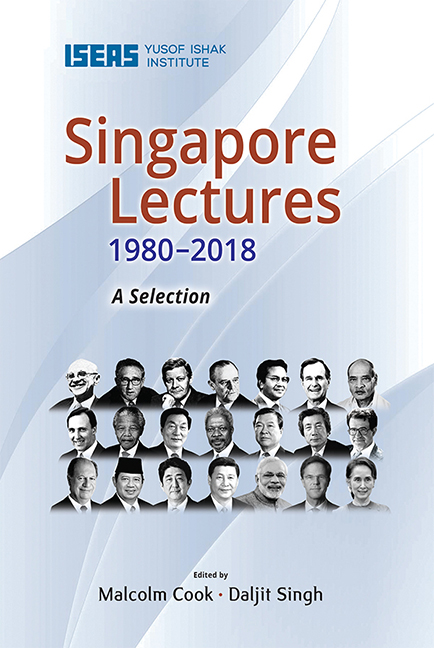Book contents
- Frontmatter
- Contents
- Introduction
- 1 The Invisible Hand in Economics and Politics
- 2 American Foreign Policy: A Global View
- 3 The Soviet Union: Challenges and Responses as Seen from the European Point of View
- 4 Trends in the International Financial System
- 5 Regionalism, Globalism and Spheres of Influence: ASEAN and the Challenge of Change into the 21st Century
- 6 US Policy in the Asia-Pacific Region: Meeting the Challenges of the Post-Cold War Era
- 7 India and the Asia-Pacific: Forging a New Relationship
- 8 Australia, Asia and the New Regionalism
- 9 South and Southern Africa into the Next Century
- 10 China and Asia in the New Century
- 11 Global Values: The United Nations and the Rule of Law in the 21st Century
- 12 Peace on the Korean Peninsula and East Asia
- 13 Japan and ASEAN in East Asia: A Sincere and Open Partnership
- 14 EU and Asia: Sharing Diversity in an Inter-regional Partnership
- 15 Global Challenges in the 21st Century: A View from Chile
- 16 Indonesia: The Challenge of Change
- 17 Japan and ASEAN, Always in Tandem: Towards a More Advantageous Win-Win Relationship through My “Three Arrows”
- 18 Forging a Strong Partnership to Enhance Prosperity of Asia
- 19 India’s Singapore Story
- 20 The Netherlands, Singapore, Our Regions, Our World: Connecting Our Common Future
- 21 Democratic Transition in Myanmar: Challenges and the Way Forward
- The Singapore Lecture Series
- The Editors
19 - India’s Singapore Story
Published online by Cambridge University Press: 09 October 2021
- Frontmatter
- Contents
- Introduction
- 1 The Invisible Hand in Economics and Politics
- 2 American Foreign Policy: A Global View
- 3 The Soviet Union: Challenges and Responses as Seen from the European Point of View
- 4 Trends in the International Financial System
- 5 Regionalism, Globalism and Spheres of Influence: ASEAN and the Challenge of Change into the 21st Century
- 6 US Policy in the Asia-Pacific Region: Meeting the Challenges of the Post-Cold War Era
- 7 India and the Asia-Pacific: Forging a New Relationship
- 8 Australia, Asia and the New Regionalism
- 9 South and Southern Africa into the Next Century
- 10 China and Asia in the New Century
- 11 Global Values: The United Nations and the Rule of Law in the 21st Century
- 12 Peace on the Korean Peninsula and East Asia
- 13 Japan and ASEAN in East Asia: A Sincere and Open Partnership
- 14 EU and Asia: Sharing Diversity in an Inter-regional Partnership
- 15 Global Challenges in the 21st Century: A View from Chile
- 16 Indonesia: The Challenge of Change
- 17 Japan and ASEAN, Always in Tandem: Towards a More Advantageous Win-Win Relationship through My “Three Arrows”
- 18 Forging a Strong Partnership to Enhance Prosperity of Asia
- 19 India’s Singapore Story
- 20 The Netherlands, Singapore, Our Regions, Our World: Connecting Our Common Future
- 21 Democratic Transition in Myanmar: Challenges and the Way Forward
- The Singapore Lecture Series
- The Editors
Summary
Prime Minister Narendra Modi of India delivered the 37th Singapore Lecture on 23 November 2015. He was introduced by Singapore Deputy Prime Minister and Coordinating Minister for Economic and Social Policies Tharman Shanmugaratnam. Prime Minister Modi was the third Indian Prime Minister to give a Singapore Lecture. Elected as leader of India only a year and a half earlier, he was riding a wave of optimism about his bold domestic and foreign policy initiatives. The lecture covers a range of subjects from India-Singapore relations to India's domestic transformation and to India in East and Southeast Asia.
Excellency, Prime Minister Lee Hsien Loong,
Excellency, Deputy Prime Minister Tharman Shanmugaratnam,
Honourable Ministers,
Professor Tan Tai Yong,
Distinguished guests,
Thank you for the honour and privilege of delivering the Singapore Lecture.
I am conscious that I walk in the footsteps of leaders who have shaped modern India and our relationship with this region—President Shri APJ Abdul Kalam, Prime Minister Shri P.V. Narsimha Rao, and former Prime Minister Shri Atal Bihari Vajpayee.
Mr Prime Minister, I am deeply honoured that you have joined us here.
We have been on the road together in the past few weeks—for the G20 and the ASEAN and East Asia Summits.
This tells you how deeply linked the destinies of our two nations are.
To the people of Singapore, on 50 years of Independence, I extend the greetings and the good wishes of 1.25 billion friends and admirers.
In the life of humans and nations, milestones of time are natural.
But, few countries can celebrate the first 50 years of existence with a sense of pride and satisfaction that Singapore deserves to.
And, I can do no better than to begin with homage to one of the tallest leaders of our time and the architect of modern Singapore—Lee Kuan Yew.
To capture his mission in his own words, he gave his life to see a successful Singapore.
And, it was with his well-known steely determination that he saw Singapore through to its golden jubilee year.
His impact was global. And, in him, India had a well-wisher, who spoke with the honesty of true friendship.
- Type
- Chapter
- Information
- Singapore Lectures 1980-2018 , pp. 273 - 279Publisher: ISEAS–Yusof Ishak InstitutePrint publication year: 2020

